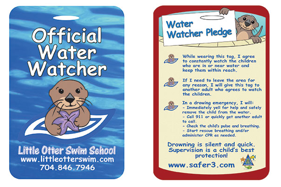By John Kirk, co-owner (along with his wife, Lory) of one of the area’s best children’s swim resources, Little Otter Swim School.
Actively supervise children in and around open bodies of water, giving them your undivided attention.
Whenever infants or toddlers are in or around water, an adult should be within arm’s reach to provide active supervision. We know it’s hard to get everything done without a little multitasking, but this is the time to avoid distractions of any kind. If children are near water, then they should be the only thing on your mind. Small children can drown in as little as one inch of water.
When there are several adults present and children are swimming, use the Waterwatcher Card Strategy, which designates an adult as the Waterwatcher for a certain amount of time (such as 15-minute periods) to prevent lapses in supervision. This is a strategy that Little Otter recommends so please ask for Little Otter’s Waterwatcher Card when you’re in one of the facilities – Matthews or Huntersville.
Start Slow With Babies
You can start introducing your babies to water when they are about 6 months old. Remember to always use waterproof diapers and change them frequently.
Educate Your Kids About Swimming Safely
Every child is different, so enroll children in swimming lessons when you feel they are ready. Swimming lessons are one layer of protection but are not a substitute for active supervision by an adult.
Make sure kids swim only in areas designated for swimming. Teach children that swimming in open water is not the same as swimming in a pool. They need to be aware of uneven surfaces, river currents, ocean undertow and changing weather.
Whether you’re swimming in a backyard pool or in a lake, teach children to swim with an adult. Older, more experienced swimmers should still swim with a partner every time. From the first time your kids swim, teach children to never go near or in water without an adult present.
Don’t Rely on Swimming Aids
Remember that swimming aids (such as water wings or noodles) are fun toys for kids, but they should never be used in place of a U.S. Coast Guard-approved personal flotation device.
Take the Time to Learn CPR
We know you have a million things to do, but learning CPR should be on the top of the list. It will give you tremendous peace of mind – and the more peace of mind you have as a parent, the better. You can even have your children learn CPR. It’s a skill that will serve them for a lifetime.
Local hospitals, fire departments and recreation departments offer CPR training.
Take Extra Steps Around Pools
A swimming pool is a ton of fun for you and your kids. Make sure backyard pools have four-sided fencing that’s at least 4 feet high and a self-closing, self-latching gate to prevent a child from wandering into the pool area unsupervised.
When using inflatable or portable pools, remember to empty them immediately after use and store them upside down and out of children’s reach.
Install a door alarm, a window alarm or both to alert you if a child wanders into the pool area unsupervised.
Check the Drains in Your Pool and Spa
Educate your children about the dangers of drain entanglement and entrapment and teach them to never play or swim near drains or suction outlets.
Pools that pose the greatest risk of entrapment are children’s public wading pools, in-ground hot tubs, or any other pools that have flat drain grates or a single main drain system.
For new pools or hot tubs, install multiple drains in all pools, spas, whirlpools and hot tubs. This minimizes the suction of any one drain, reducing risk of death or injury. If you do have drains, protective measures include anti-entrapment drain covers and a safety vacuum release system to automatically release suction and shut down the pump should entrapment occur.
Regularly check to make sure drain covers are secure and have no cracks, and replace flat drain covers with dome-shaped ones. If a pool or hot tub has a broken, loose or missing drain cover, don’t use it.
If you do have drains, protective measures include anti-entrapment drain covers and a safety vacuum release system to automatically release suction and shut down the pump should entrapment occur. PoolSafely.gov has a list of manufacturers of certified covers.
Check to make sure your pool or hot tub’s drains are compliant with the Pool and Spa Safety Act.
John Kirk is co-owner (along with his wife, Lory) of one of the area’s best children’s swim resources – Little Otter Swim School. Learn more about swim lessons that are available at both of Little Otter’s locations – Matthews and Huntersville – where the passion for teaching quality swimming is obvious.
![]()
Little Otter Charlotte
8200 Tower Point Drive
Charlotte, NC 28227
Little Otter Huntersville
14415 Reese Boulevard
Huntersville, NC 28078



